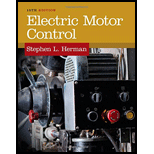
Concept explainers
Describe how pressure switches are connected to start and stop (a) small motors and (b) large motors.
(a)
Explain how does the pressure switches are connected to start and stop small motors.
Answer to Problem 1SQ
The pressure switches are connected directly to start and stop small motors.
Explanation of Solution
Discussion:
In industrial applications, the pressure switches are used to sense pressure. A large variety of pressure switches are available to control the requirements of hydraulic machines or pneumatic machines.
Single-pole pressure switches are most commonly used and Two-pole pressure switches are used only for few applications.
In small motors, the pressure switches are directly connected to the load circuits when the capacities of the contact are sufficient for the load current.
Conclusion:
Thus, the pressure switches are connected directly to start and stop small motors.
(b)
Explain how does the pressure switches are connected to start and stop large motors.
Answer to Problem 1SQ
The pressure switches are connected series with motor starter and line to start and stop large motors.
Explanation of Solution
Discussion:
In industrial applications, the pressure switches are used to sense pressure. A large variety of pressure switches are available to control the requirements of hydraulic machines or pneumatic machines.
Single-pole pressure switches are most commonly used and Two-pole pressure switches are used only for few applications.
In large motors, the pressure switches alone cannot handle the load circuits safely where it must be connected in series with the motor starter coil and line such that the starter can start and stop large motors safely.
Conclusion:
Thus, the pressure switches are connected in series with motor starter and a line are to start and stop large motors.
Want to see more full solutions like this?
Chapter 10 Solutions
Electric Motor Control
- If C is the circle |z|=4 evaluate f f (z)dz for each of the following functions using residue. 1 f(z) = z(z²+6z+4)arrow_forwardIf C is the circle |z|=4 evaluate ff(z)dz for each of the following functions using residue. f(z) z(z²+6z+4)arrow_forwardDetermine X(w) for the given function shown in Figure (1) by applying the differentiation property of the Fourier Transform. 1 x(t) Figure (1) -2 I -1 1 2arrow_forward
- Please solve it by explaining the steps. I am trying to prepare for my exam tomorrow, so any tips and tricks to solve similar problems are highly appreciated. Plus, this is a past exam I am using to prepare.arrow_forwardPlease solve it by explaining the steps. I am trying to prepare for my exam tomorrow, so any tips and tricks to solve similar problems are highly appreciated. Plus, this is a past exam I am using to prepare.arrow_forwardPlease solve it by explaining the steps. I am trying to prepare for my exam tomorrow, so any tips and tricks to solve similar problems are highly appreciated. Plus, this is a past exam I am using to prepare.arrow_forward
- Please solve it by explaining the steps. I am trying to prepare for my exam tomorrow, so any tips and tricks to solve similar problems are highly appreciated. Plus, this is a past exam I am using to prepare.arrow_forwardPlease solve it by explaining the steps. I am trying to prepare for my exam tomorrow, so any tips and tricks to solve similar problems are highly appreciated. Plus, this is a past exam I am using to prepare.arrow_forwardPlease solve it by explaining the steps. I am trying to prepare for my exam tomorrow, so any tips and tricks to solve similar problems are highly appreciated. Plus, this is a past exam I am using to prepare.arrow_forward
- Please solve it by explaining the steps. I am trying to prepare for my exam tomorrow, so any tips and tricks to solve similar problems are highly appreciated. Plus, this is a past exam I am using to prepare.arrow_forwardPlease solve it by explaining the steps. I am trying to prepare for my exam tomorrow, so any tips and tricks to solve similar problems are highly appreciated. Plus, this is a past exam I am using to prepare.arrow_forwardPlease solve it by explaining the steps. I am trying to prepare for my exam tomorrow, so any tips and tricks to solve similar problems are highly appreciated. Plus, this is a past exam I am using to prepare.arrow_forward
